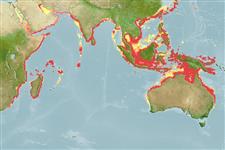>
Eupercaria/misc (Various families in series Eupercaria) >
Haemulidae (Grunts) > Haemulinae
Etymology: Pomadasys: Greek, poma, -atos = cover, operculum + Greek, dasys = with hair (Ref. 45335).
More on author: Cuvier.
Environment: milieu / climate zone / depth range / distribution range
Écologie
marin; saumâtre récifal; profondeur ? - 75 m (Ref. 2799). Tropical; 32°N - 32°S, 18°E - 154°E
Indo-West Pacific: Red Sea and east coast of Africa to southeast Asia, north to Taiwan, south to Queensland, Australia. Also reported from Persian Gulf (Ref. 68964).
Length at first maturity / Taille / Poids / Âge
Maturity: Lm ?, range 35 - ? cm
Max length : 80.0 cm TL mâle / non sexé; (Ref. 5213); common length : 50.0 cm TL mâle / non sexé; (Ref. 30573)
Épines dorsales (Total): 12; Rayons mous dorsaux (Total): 13-15; Épines anales 3; Rayons mous anaux: 7. This species is distinguished by the following characters: chin with 2 pores with a median pit; D XII,13-15 (usually 14 ½); A III,7; scales ctenoid (rough to touch); lateral line scales 43-50; scales between lateral line and dorsal-fin origin 7; scales around caudal peduncle 20, 9 above lateral line and 9 below; body depth 2.5 to 3 times in standard length; head blunt, its upper profile convex; mouth small; maxilla reaching to eye; teeth in jaws arranged in villiform (brushlike) bands; swimbladder without anteriolateral horn-like extensions. Colour: juveniles brilliant silvery green above to golden silver on sides and silvery white on belly with 12 or more faint vertical bars comprised of small dark brown spots or irregular blotches; dorsal fin spotted with black-brown spots on lower half of spinous dorsal fin and in 3 rows on rayed dorsal fin; margin of soft dorsal fin darker and lower tip of caudal fin milk white; adults uniform golden green above, silvery below with traces of the vertical bars present only when alive and spots on dorsal fins indistinct or absent (Ref. 47695).
Inhabit turbid inshore waters with sandy to muddy bottoms to a depth of 75 m. Enter estuaries, may tolerate water with low salinity. Often associated with inshore wrecks (Ref. 4332). Feed on crustaceans and fish (Ref. 5213, 48635). Spawners form shoals near river mouths during the winter. Good food fish (Ref. 2799). Taken by handline, set net, trap, and spear. Marketed fresh, a small quantity is salted or smoked (Ref. 47695).
Life cycle and mating behavior
Maturité | Reproduction | Frai | Œufs | Fécondité | Larves
Oviparous, distinct pairing during breeding (Ref. 205).
Smith, M.M. and R.J. McKay, 1986. Haemulidae. p. 564-571. In M.M. Smith and P.C. Heemstra (eds.) Smiths' sea fishes. Springer-Verlag, Berlin. (Ref. 2799)
Statut dans la liste rouge de l'IUCN (Ref. 130435)
Menace pour l'homme
Harmless
Utilisations par l'homme
Pêcheries: commercial; Aquaculture: commercial; pêche sportive: oui
Plus d'informations
RéférencesAquacultureProfil d'aquacultureSouchesGénétiqueElectrophoresesHéritabilitéPathologiesTraitementNutrientsMass conversion
CollaborateursImagesStamps, Coins Misc.SonsCiguateraVitesseType de nageSurface branchialeOtolithesCerveauxVision
Outils
Articles particuliers
Télécharger en XML
Sources Internet
Estimates based on models
Preferred temperature (Ref.
123201): 24.1 - 29, mean 28 °C (based on 1730 cells).
Phylogenetic diversity index (Ref.
82804): PD
50 = 0.5000 [Uniqueness, from 0.5 = low to 2.0 = high].
Bayesian length-weight: a=0.01413 (0.01161 - 0.01718), b=2.98 (2.94 - 3.02), in cm total length, based on LWR estimates for this species (Ref.
93245).
Niveau trophique (Ref.
69278): 3.5 ±0.53 se; based on food items.
Résilience (Ref.
120179): Milieu, temps minimum de doublement de population : 1,4 à 4,4 années (K=0.25-0.57).
Prior r = 0.88, 95% CL = 0.58 - 1.32, Based on 2 stock assessments.
Fishing Vulnerability (Ref.
59153): Moderate vulnerability (38 of 100).
Climate Vulnerability (Ref.
125649): High to very high vulnerability (72 of 100).
Nutrients (Ref.
124155): Calcium = 27.3 [9.6, 52.0] mg/100g; Iron = 0.506 [0.264, 0.870] mg/100g; Protein = 19.7 [17.9, 21.5] %; Omega3 = 0.137 [0.077, 0.230] g/100g; Selenium = 39.7 [23.7, 68.3] μg/100g; VitaminA = 46.5 [17.5, 123.4] μg/100g; Zinc = 1.09 [0.76, 1.60] mg/100g (wet weight);
